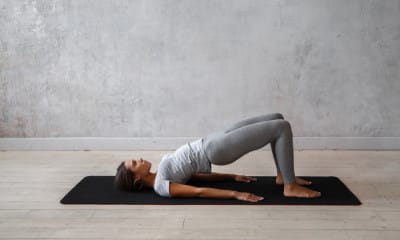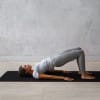These 5-Heart-Pumping Variation Could Be Your Next Best Jumping Jacks
Whether you’re a jumping jack fanatic or you haven’t done a jumping jack since middle school gym class, there’s one thing (okay, two things) most of us can agree on: jumping jacks are fun (they make you feel like a kid again) and they are definitely a workout—a total body workout.
Jumping jacks mix cardio and resistance work in one swift move (er, jump), while engaging multiple muscles, including the glutes, hamstrings, quads, and calves, as well as the muscles of the core, back, and shoulders. Plus, jumping jacks are easy to incorporate into different workouts or they can serve as a standalone workout, making them easy to squeeze into a busy schedule. Talk about efficiency.
Ready to get your jumping jacks on? Keep reading to learn some of the benefits of doing jumping jacks, a how-to on the proper way to do a jumping jack (plus some variations to try once you’re ready to kick things up a notch!), some ways to work the move into your exercise routine, and tips for preventing injuries.
Benefits of doing jumping jacks
No equipment or ample space is needed
One of the many beauties of jumping jacks is that all you need is you, so there are no excuses for not squeezing them in whenever you can (say, between Zoom meetings). Plus, minimal space is needed, making it an ideal at-home exercise.
You can adjust the move to your fitness level
Jumping jacks work no matter how in shape you are. You can make modifications if needed or switch things up with variations if you want to make it more challenging, says Jennifer Nagel, an ACE-certified personal trainer.
They’re good for heart health
“Jumping jacks, like other forms of aerobic and anaerobic exercise, support overall health by improving cardiovascular health, lowering blood pressure, helping to manage weight, and improving sleep,” Nagel says.
How to do a jumping jack
Let’s take it back to basics. Here, Nagel shares a step-by-step refresher on how to do jumping jacks the right way.
- Start in a standing position, facing forward. Feet should be together and your hands should be at your sides.
- Next is the jumping part: “Jump your feet out laterally while bringing your arms up and above your head,” Nagel says. “Land softly on your feet with a slight bend in the knees.”
- Finally, jump your feet back to their starting position while bringing your hands back down to your sides. Remember to land softly with your knees slightly bent. Improper landing can put a lot of extra force on your knees and ankles.
- Repeat for your desired number of repetitions.
5 jumping jack variations
Now, let’s get creative with it. Here are some jumping jack variations you can try.
Watch trainer Billie Robyn demonstrate an open-arm jumping back below, then keep scrolling for more variations:
Modified jumping jacks (step-outs)
If regular jumping jacks are too much for you, no big deal. Opt for modified jacks instead. To do them, begin in the same standing position facing forward with your feet together. Then, Nagel says, step one leg out while bringing both of your arms overhead. Then return to the starting position and repeat with the other leg.
Squat jacks
Mix a squat with a jumping jack, and you’ve got a squat jack. Prepare to feel the burn. Begin in the same starting position and jump your feet out laterally while bringing your arms up and above your head like in a regular jumping jack. The difference, Nagel says, is that with a squat jump, you land in a sumo squat position with your feet turned out about 45 degrees. Then jump both feet back into the starting position as you bring both hands back to your sides.
Straight arm jumping jacks
Nagel instructs to begin in the same starting position as you do for regular jumping jacks and jump your feet out to the sides as usual. As the name suggests, the shakeup with these is that you bring your arms straight up above your head with your palms facing each other. Then jump your feet back into the starting position and bring your hands down to your sides. To make these more challenging, Nagel suggests adding light weights.
Lateral raise jumping jacks
Your feet do the same thing, but your arms are bent at the elbows at a 90-degree angle. “Jump your feet out laterally while raising your arms to shoulder level, parallel to the ground,” Nagel says. “Jump both feet back into your starting position while bringing your hands back to your sides. Maintain the 90-degree angle of your arms throughout the exercise.” You can also add light weights to make these more difficult.
Jumping jacks with mini bands
Adding exercise bands to your jumping jacks is an easy way to take this OG move to the next level. “Light, medium, or heavy resistance mini bands can be added to any of the jumping jack variations above to engage your abductors—side of the glutes/hips—and add an additional challenge,” Nagel says. “Place the mini-band around your legs, just above the knee, or around the ankles.”
How to incorporate jumping jacks into your workout routine
Use them to warm up
Jumping jacks are a go-to warm up. “Begin with rotating the ankles, hugging the knees, and arm circles to warm up the joints, then begin doing jumping jacks slowly—or do a modified jumping jack—then move to a regular tempo,” Nagel says. “Do jumping jacks for three to five minutes.”
Make it a circuit
“If you’re short on time, you can do different types of jumping jacks for about 10 minutes for a quick cardio workout, or you can organize jumping jacks in a circuit with short periods of rest in between intervals,” Nagel says.
Do them in between weighted sets
“Superset jumping jacks with other weighted movements or use a lower impact modification as an active recovery exercise in between sets,” Nagel says.
If you’re looking to incorporate jumping jacks into your exercise routine, this 25-minute cardio barre workout is a great place to start:
How to prevent injuries
Jumping jacks may seem super simple but, like any exercise, they can potentially cause injury. Here are some safety tips and guidelines to follow.
Check with your healthcare provider
If you are pregnant, have injuries, or other pre-existing conditions, Nagel recommends checking with your doctor first to discuss the best exercise program for you. Typically, pregnant women who have been doing high-impact exercise can continue to do jumping jacks. However, balance changes may increase the risk of falling, so modified jumping jacks are a safer bet.
Modify them if you have knee or ankle issues
Higher impact exercises such as jumping jacks may not be the best for folks with knee or ankle problems. Nagel recommends the modified (step-out) jumping jacks to help reduce the extra stress on the joints.
Warm-up first
Although jumping jacks can be a warm-up exercise in and of themselves, Nagel still recommends doing some pre-warm ups before you start jumping. These can include ankle rotations, knee hugs, and arm circles to get your joints ready for the exercise.
Wear supportive shoes
The shoes you wear while doing jumping jacks also matter. Nagel’s tip is to opt for sneakers that support higher impact movements.
















